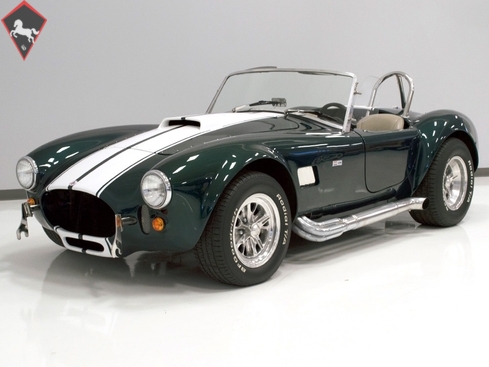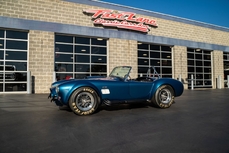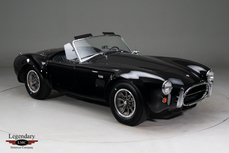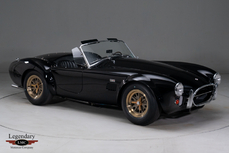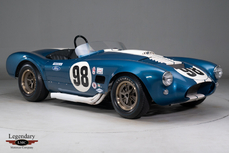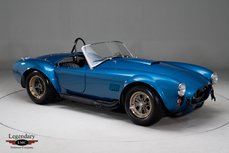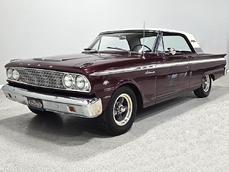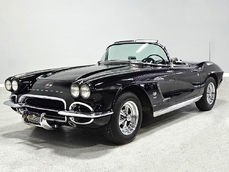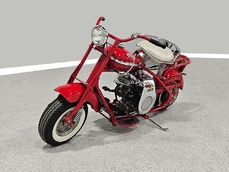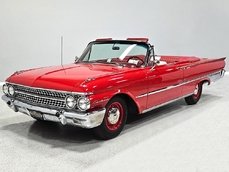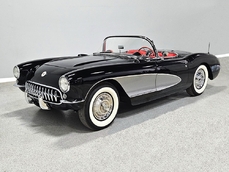Shelby Cobra 427 302 cubic inch V8 1965
General description :
Like everyone else selling a Cobra replica, I could start by telling you that the originals are seven-figure cars today and that this Shamrock Cobra replica is a more affordable way to own one. That’s true, of course, but it kind of misses the point. Cobra replicas have become a thing unto themselves, a vast industry with surprisingly high standards of performance and quality, churning out some delightfully functional sports cars that just happen look like original Cobras. Buying a replica like this Shamrock Cobra isn’t necessarily about trying to replicate the experience of the original, but rather celebrating minimalist horsepower, an open cockpit, and curvaceous bodywork, which were never more beautifully combined than in the Shelby Cobra. So no, I don’t think the experience of driving this car will make you feel like you spent a million dollars on it. What I know for certain, however, is that getting behind the wheel, lighting the fires, and hammering the throttle will make you grin so hard your face muscles will hurt when you get home. And THAT is why Cobra replicas are so awesome.
There seems to be a hierarchy of Cobra manufacturers, and Shamrock seems to enjoy a better reputation than most. It isn’t intended to be an exact replica, so you’ll see a stretch here and a tuck there, all intended to make their cars a bit more user-friendly. Professionally built and showing just 1204 miles on the clock, this is a great way to get into a Cobra right now, without the wait or expense of building your own. You can’t argue with the color combination, which is a lovely metallic Hunter Green with traditional Wimbledon White stripes, and a Cobra without stripes isn’t finished, I don’t care what you say. The heavy-duty fiberglass bodywork is nicely finished with good prep, flat surfaces, and panel gaps that are better than expected for a hand-built machine. The doors open and close easily, the trunk latches well, and you don’t have to slam the hood to get it close and it elevates itself on a pair of gas-charged struts. The paint is two-stage urethane that has a great shine, and while there are a few signs of use (most notably on the low-hanging chin), there’s nothing that needs attention. You’ll note it’s got race-style jacking stubs instead of bumpers, correct Lucas-style taillights, and a flip-up gas cap that should probably be standard equipment on every Cobra replica. The chrome windshield frame offers both wind wings and tinted Plexiglas sun visors and the exposed rivets on the hood are a link to the aluminum bodies that cost so many tens of thousands of dollars.
The tan leather interior (yes, it’s leather, not vinyl) is the ideal complement to the Hunter Green bodywork. It’s tasteful but functional, with wrap-around buckets that hold you in place without being constricting, and the low-back profile works perfectly in the low-slung Cobra bodywork. It’s finished for comfort as much as speed, so you get full door panels, black carpets, and a lot of rather nicely done French seams on the stitching. The dashboard is wrapped in more tan leather and uses familiar Smiths gauges, including the reverse-rotation speedometer that was a feature for many years. A set of warning lamps for high beams, alternator, and turn signals are in their own neat housing, while secondary controls for the wipers and headlights are on stalks on the steering column. The fat steering wheel feels racy and connects you directly to the front wheels, and the smaller diameter actually makes it a lot easier to slide behind the wheel than many replicas out there. The hides remain supple and comfortable and the carpets are unmarked, indicative of the low mileage, and everything works properly. Weather protection is, well, nil, but you do get a full cockpit tonneau as well as a frame for the top and a set of side curtains, so a top could probably be procured easily to make this car functional for longer trips in inclement weather. The trunk is also fully upholstered to hide the fuel cell and the battery has its own heavy-duty aluminum box.
The original Cobras used both small and big block engines, and if you ask the guys who actually used them as intended, most will tell you that a small block car is better balanced and almost as fast. A good majority of replicas run small block motors as well, for the very same reasons, and it’s probably why there’s a stout 302 cubic inch Ford V8 living under the hood today. Better known as the 5.0, it makes legendary torque and offers bulletproof reliability in its current under-stressed form. With a big Holley double-pumper carburetor and those wonderful side pipes, it has immediate throttle response and a big engine soundtrack to go along with it. The engine bay is quite neatly finished with plenty of chrome and polished aluminum, including the beautiful expansion tank for the cooling system. The radiator is tucked in at the nose of the car and uses a big electric fan to keep things cool and service access is awesome, although with this setup, you’ll spend far more time behind the wheel than under the hood. It starts easily with a bark from the side pipes and it idles well after a few seconds of warming up. There’s plenty of oil pressure, it doesn’t get fussy in traffic, and, well, this is how you always dreamed your Cobra would run.
The transmission is a Tremec T3550 5-speed manual feeding a Jaguar independent rear end with inboard disc brakes, twin coil-over shocks, and 3.73 gears inside, so acceleration is explosive at any speed. Shamrock used their own welded rectangular tube frame chassis which is heavily reinforced and braced, making a great platform for a lightweight performance car. The front suspension also appears to be from a Jaguar, including A-arms and big vented brake discs, which brings us to this Cobra’s most remarkable feature: the ride. For a lightweight 2-seat sports car with a giant V8 up front, you’d expect, even welcome, a tooth-rattling ride. This Cobra is different, offering crisp handling but a supple, comfortable ride that means you can enjoy it regularly without a second thought, and, perhaps more importantly, your significant other will never complain about how rough it is. The brakes are firm and confidence-inspiring, and it wears the right wheels: polished Halibrands with knock-offs wrapped in 235/60/15 front and 275/60/15 rear BFGoodrich T/A radials.
So please, don’t look at this as a cut-rate Cobra substitute, because that’s not giving it full credit. It’s a raw, elemental, 2-seat sports car with an all-American soundtrack, a huge wallop of torque on tap at any speed, and it’s far more comfortable than you’d ever expect. Come take it for a drive, we promise you’ll be surprised by just how sophisticated this car really feels.
http://www.harwoodmotors.com/vehicles/inventory_details.php?id=705
1965 Shelby Cobra 427 302 cubic inch V8 is listed sold on ClassicDigest in Macedonia by for $37900.
Car Facts
Car type : Car Make : Shelby Model : Cobra 427 Model Version : 302 cubic inch V8 Engine size : 0.0 Model Year : 1965 Location : Ohio
Sold
Seller Information
Sold
People who viewed this Shelby Cobra 427 also viewed similar Shelby listed at ClassicDigest
Other cars listed for sale by this dealer
About Shelby
Carroll Shelby, a legendary figure in the automotive world, had a remarkable journey from being a successful race car driver to becoming a renowned sports car manufacturer in the United States. His story is filled with achievements, innovations, and iconic cars that left an indelible mark on the industry.Early Years and Racing Career:
Carroll Shelby was born in 1923 in Texas. He initially pursued a career as a pilot during World War II but found his true passion in racing after the war. Shelby became a successful race car driver in the 1950s, competing in various events including Formula One, endurance racing, and the famous 24 Hours of Le Mans.
Shelby Cobras - Iconic Sports Cars:
Carroll Shelby's pivotal moment as a manufacturer came with the creation of the Shelby Cobra, an iconic American sports car. The Cobra was born from the fusion of a British AC Ace chassis and a Ford V8 engine, creating a lightweight, high-performance car that dominated tracks and streets alike. Key models include:
Shelby Cobra 260 (1962): The initial version with a 260 cubic inch (4.2L) V8 engine.
Shelby Cobra 289 (1963-1965): Later iterations with a 289 cubic inch (4.7L) V8 engine, including the competition-spec Cobras known for their racing prowess.
Shelby Cobra 427 (1965-1967): The most powerful iteration with a 427 cubic inch (7.0L) V8 engine, known for its raw power and performance.
Ford Partnership - Shelby Mustangs:
Shelby's partnership with Ford led to the creation of legendary Shelby Mustangs. The most notable model is:
Shelby GT350 (1965-1969): Based on the Ford Mustang, the GT350 was modified by Shelby American, featuring enhanced performance, handling, and distinct styling.
Other Notable Models and Achievements:
Beyond the Cobras and Mustangs, Shelby had several other significant contributions:
Shelby Daytona Coupe: Created to win against Ferrari in international GT racing, this car became the first American car to win the FIA GT World Championship in 1965.
Shelby Series 1: Introduced in the late 1990s, this was Shelby's modern take on a high-performance sports car.
Ford GT40 plays a pivotal role in Carroll Shelby's narrative, especially in his connection to Ford and his significant contribution to the car's success.
The Ford GT40 Development:
Ford's Challenge:
In the early 1960s, Henry Ford II sought to acquire Ferrari, but negotiations fell apart. This spurred Ford's determination to beat Ferrari at the prestigious 24 Hours of Le Mans endurance race, which Ferrari had dominated for several years.
Collaboration with Shelby:
Ford turned to Carroll Shelby, recognizing his racing expertise and track record. Shelby was tasked with leading the GT40 project and turning it into a competitive race car capable of challenging Ferrari's supremacy.
Development and Triumph:
Under Shelby's guidance, the Ford GT40 underwent rigorous development to address initial design flaws and performance issues. Several iterations were produced:
Early Attempts: The initial versions of the GT40 faced reliability and handling issues, leading to disappointing results at Le Mans in 1964.
GT40 Mark II: Shelby's team made crucial improvements. The Mark II, equipped with a powerful V8 engine, improved aerodynamics, and refined engineering, became highly competitive.
Le Mans Victory:
In 1966, the Ford GT40 Mark II achieved a historic victory at the 24 Hours of Le Mans, with Shelby-coached driver Ken Miles leading the race. This marked the first win for an American manufacturer at Le Mans, breaking Ferrari's dominance.
Continued Success:
The GT40 continued to dominate, winning Le Mans for the following three years (1966-1969), securing its place in racing history and solidifying Ford's reputation as a force in international motorsport.
Shelby's Contribution to the GT40 Success:
While Carroll Shelby wasn't directly involved in designing the GT40, his expertise in racing and his ability to assemble and lead a team of talented engineers, mechanics, and drivers were instrumental in refining the car's performance. His influence helped address technical issues, refine the car's handling, and strategize race tactics, contributing significantly to the GT40's success on the track.
Legacy and Impact:
The Ford GT40's victories at Le Mans under Shelby's guidance remain one of the most iconic achievements in motorsport history. The car's success solidified Shelby's reputation as an automotive visionary and further strengthened his partnership with Ford.
Carroll Shelby's involvement in the GT40 project showcased his ability to transform a struggling project into a championship-winning machine, adding another remarkable chapter to his illustrious career in the automotive world.
